Over Site: how Caracas's new cable-car system is making the city's favelas more visible
Texto por David Sokol
Washington, DC, Estados Unidos
29.07.10
Once so disenfranchised that they didn't even appear on maps of the city, Caracas's favelas are, thanks to projects such as the technically and politically remarkable MetroCable transport system in San Agustín, acquiring a social legitimacy. Here, we talk to architect Alfredo Brillembourg, co-founder of the multidisciplinary practice Urban Think Tank, about the development of the cable-car system and how it works to fill in those cartographic blanks.
Until recently, the Caracas city map demonstrated tunnel vision on an urban scale. The giant voids that could be seen on the map were, in fact, favelas; government officials ignored the hillside slums and inserted emptiness in their place. And although the hugely populated favelas are as vibrant as they are ingenious – hacking into the electrical infrastructure of adjacent redevelopments to power themselves, for example – the city had planned, earlier in the decade, to fill in the 40,000-person non-place known as San Agustín with a tremendous new highway. The river of pavement would have required demolishing one third of the homes there.
Caracas and New York-based practice Urban Think Tank's MetroCable system operates over the Venezuelan capital's San Agustín favelas; photo courtesy Urban Think Tank – Alfredo Brillembourg
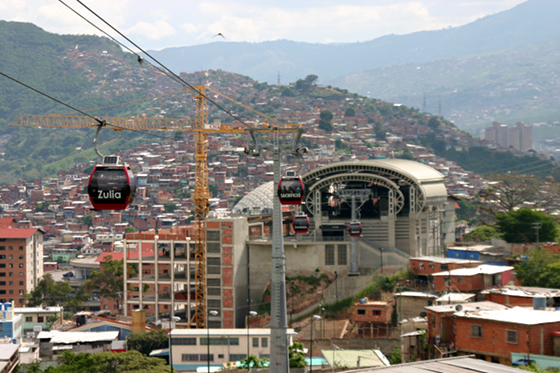
Caracas and New York-based practice Urban Think Tank's MetroCable system operates over the Venezuelan capital's San Agustín favelas; photo courtesy Urban Think Tank – Alfredo Brillembourg
×Architects Alfredo Brillembourg and Hubert Klumpner, founders of the studio Urban Think Tank, saw these voids differently and wanted to give them voice. In July 2003, they organized a symposium at Caracas’s central university to protest against the road building. The event allowed participating residents not only to express San Agustín’s right to exist, but also to outline their vision for local prosperity. The government could devote its resources to, say, safety amenities and business opportunities that would allow the community to sustain itself in a constellated and holistic way.
The cable-car system was constructed after plans to build a highway through the favelas were protested against and finally dropped; photo courtesy Urban Think Tank – Alfredo Brillembourg
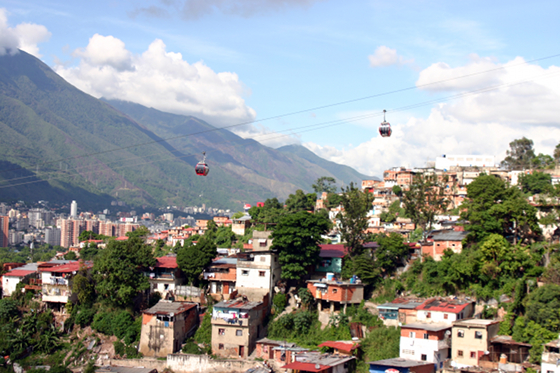
The cable-car system was constructed after plans to build a highway through the favelas were protested against and finally dropped; photo courtesy Urban Think Tank – Alfredo Brillembourg
×Felled by the grassroots campaign, Caracas scrapped its original plans, and subsequently a task force started work on a cable-car alternative. Urban Think Tank, with the Austrian ropeway manufacturer Doppelmayr and engineers at Silman & Associates, as well as Transolar, then refined the Caracas MetroCable concept. Since it opened last year, five stations have been moving 1,200 people an hour through San Agustín in a broad 2.1-kilometre-long arc, connecting to the metro system at both ends.
In comparison to the highway, Caracas MetroCable ostensibly inverts infrastructure. Instead of wiping out whole swathes of neighbourhood, MetroCable stations are positioned flexibly, and their configuration on stilts promises minimally invasive footprints. And instead of speeding trips for the enfranchised vehicle owners of Caracas, MetroCable directly benefits the people of San Agustín – largely pedestrian, hemmed in by boundaries of multiple kinds, and located at a 45-minute, 600-step remove from the Parque Central Metro station.
MetroCable features five stations and joins up with Caracas's metro system at either end; photo courtesy Urban Think Tank – Alfredo Brillembourg

MetroCable features five stations and joins up with Caracas's metro system at either end; photo courtesy Urban Think Tank – Alfredo Brillembourg
×Urban Think Tank’s design and realization of the five MetroCable stations also evokes the construction of San Agustín. “The shape of [barrio] buildings and blocks emerges from a bottom-up process,” says Brillembourg. “Houses are gradually built up with rectangular units, using available construction materials such as reinforced masonry, blocks, and scrap metal. Overhangs cantilevered over passageways, multiple levels, and bridging are common features.” MetroCable stations’ corrugated steel sheets and fibreglass cladding echoes the materiality of San Agustín, and its barrel roofs recall those shady cantilevers. To be sure, Brillembourg also notes the Corbusian pedigree of the MetroCable scheme: As a vintage drawing of steel framing flashes across his laptop, Brillembourg explains that Corbu had imagined any number of functions (in this case, Belgian social housing) being inserted into a highly adaptable armature. In further contrast, he points out that “slum morphology results from numerous small and individual decisions, rather than from planning”, while MetroCable is very much planned. But in their simple, modular construction, and their ability to be altered or expanded nimbly, the stations wed academic modernism to the exigencies of life in the developing world.
Since it opened in 2009, MetroCable has been transporting over 1,200 local residents an hour; photo courtesy Urban Think Tank – Alfredo Brillembourg

Since it opened in 2009, MetroCable has been transporting over 1,200 local residents an hour; photo courtesy Urban Think Tank – Alfredo Brillembourg
×If Urban Think Tank’s design privileges the fabric, mindset, and aesthetic of San Agustín, then it is partly because it intends for community-oriented functions to slip into these stations. One building is large enough to include 40 residential units to replace housing that was removed for the MetroCable system; another will include a daycare facility. Because there are no local organizations to operate those and other uses immediately, the municipality is shepherding their formation. In another measure of community self-reliance, crews are beginning to install wind turbines that will power the MetroCable stations themselves, and forthcoming photovoltaic arrays will eventually supply energy to all of San Agustín.
Though utilities and social services are still in the works, San Agustín has already established a symbiosis with Caracas MetroCable. “Residents have begun to use the station roofs for advertising their businesses, and crime rates have dropped because criminals fear they’ll be seen from the gondolas,” Brillembourg reports happily. “For Urban Think Tank, we view the cable car not as a solution for all the problems these communities are facing, but as the base for the solution – an infrastructure for social change.”
“Our concept is based in architecture that has the ability to change according to the transformation of the informal city and the dynamics among its inhabitants," says Alfredo Brillembourg; photo courtesy Urban Think Tank – Alfredo Brillembourg
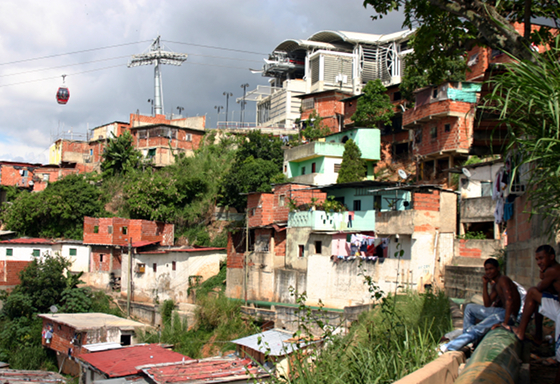
“Our concept is based in architecture that has the ability to change according to the transformation of the informal city and the dynamics among its inhabitants," says Alfredo Brillembourg; photo courtesy Urban Think Tank – Alfredo Brillembourg
×Urban Think Tank was founded in 1999 and it has focused on underprivileged Latin American communities since 2001. MetroCable is but one example of its approach: daintily inserting small-scale works – community gyms, a concert hall – into underused spaces, and whose effects ramify far into the barrios. One can’t help, then, but compare that approach with the spectacular revitalization of Medellín, Colombia’s second largest city, begun by former mayor Sergio Fajardo, and which also includes a cable-car system. Brillembourg says the predecessor tramway has weaknesses. “One is the cable-car system is just a straight line [rather than serving a broader community]; the other is that it mirrors a road network, whereas our hill, San Agustín, should survive solely without cars.” Speaking more broadly, Brillembourg indicates no intention of he and Klumpner modelling their efforts in Caracas, or modifying their approach in general, to parrot the Medellín renaissance.
One of the cable-car stations contains 40 residential units that replace housing that was removed during the MetroCable system's construction; photo courtesy Urban Think Tank – Alfredo Brillembourg
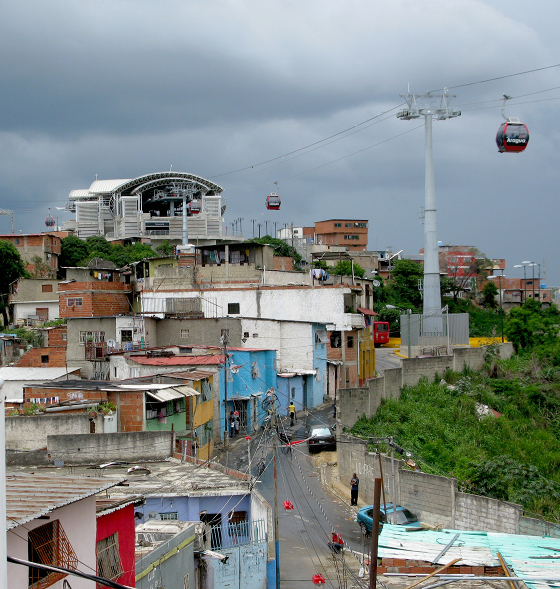
One of the cable-car stations contains 40 residential units that replace housing that was removed during the MetroCable system's construction; photo courtesy Urban Think Tank – Alfredo Brillembourg
×Certainly, Brillembourg comments approvingly of the programs these contemporary monuments house. The highly regarded faceted building designed by Giancarlo Mazzanti includes a library inside its black diamond–like form, for example. “But what about empowering little micro-libraries in individual homes?” he asks. “Every person becomes a curator of culture and history, and you’ve empowered streets and social networks as classrooms without walls.” Then there is the new morphology on display. “Medellín made some very good public places, but it commissioned architecture that wants to be European. We believe that’s a mistake. Latin American architects and schools must come up with a language of their own.”
At a time when activist architecture itself is nascent, Urban Think Tank is championing the phenomenon as well as pushing it forward. Its favela buildings refute traditional architecture that, as Brillembourg puts it, “concentrates capital in one formal building”. And in so doing, these interventions “could balance the competition between formal and informal settlements for commodities such as land, water, food, and energy”. Redistributing resources begets other redistributed resources, in other words, and Urban Think Tank urges that such undertakings embrace their own visual and spatial vocabulary.
Architect Alfredo Brillembourg: “We view the cable car not as a solution for all the problems these communities are facing, but as the base for the solution”; photo courtesy Urban Think Tank – Alfredo Brillembourg
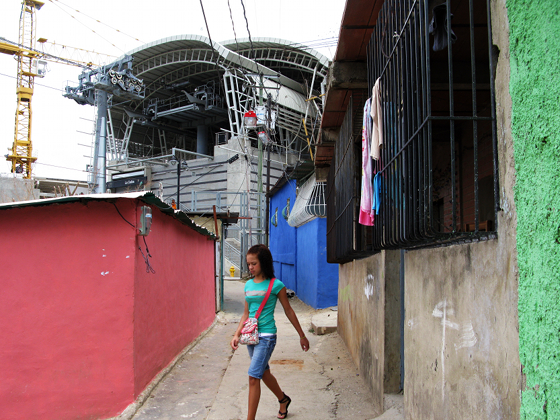
Architect Alfredo Brillembourg: “We view the cable car not as a solution for all the problems these communities are facing, but as the base for the solution”; photo courtesy Urban Think Tank – Alfredo Brillembourg
×This choreographing of favela ecologies and a favela idiom can only be realized with the active participation of its residents. “Our experiences at Urban Think Tank have taught us that architects must be advocates for the users, and that change must be accomplished thoughtfully and carefully, one step at a time, so as to be viable and durable,” says Brillembourg. And as progressive as that effort and its results may be, humility is a prerequisite. “Our concept is based in architecture that has the ability to change according to the transformation of the informal city and the dynamics among its inhabitants. We only provide the framework for future adaptation.”






